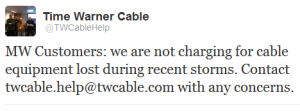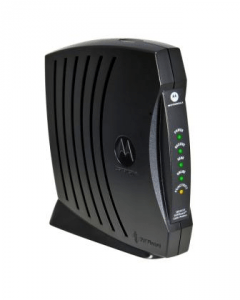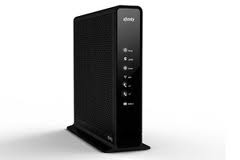 Time Warner Cable is letting victims of recent devastating storms spend their time and energy worrying about rebuilding their lives and not ponder the loss of company-owned cable boxes, modems, and other equipment.
Time Warner Cable is letting victims of recent devastating storms spend their time and energy worrying about rebuilding their lives and not ponder the loss of company-owned cable boxes, modems, and other equipment.
Unlike several smaller cable companies that have hounded customers for cable equipment destroyed in storms, fires, and other natural disasters, Time Warner is signaling they are waiving any lost/damaged equipment fees when tragedy strikes.
Many cable operators expect to recoup lost or damaged equipment from proceeds of insurance claims, and relentlessly bill clients for the full value of equipment that may have melted in a fire or blown blocks away in a tornado. While homeowner and rental policies traditionally cover this equipment, few customers are in a state of mind to worry about a DVR box or cable modem, and some may have to wait weeks or months for restitution from the insurance company.
Stop the Cap! reader Kathleen is now an extended guest at a Kentucky “extended stay” motel after her house was damaged by a tornado several days ago.
“I’m an organized person and I had my emergency planning kit ready to go, calling the insurance company, the utilities, and the cable company, among others, to make sure everything was documented,” Kathleen writes. “Our DVR box and cable modem are probably sitting in a field in southern Ohio right now, as the storm completely took away our family room.”
Kathleen originally was planning to write complaining Time Warner wanted several hundred dollars for the lost equipment because that is what the first representative told her.
 “But 20 minutes after that call, a supervisor called us back and profusely apologized, telling us the representative was not supposed to charge for the lost equipment because of the storm,” Kathleen says. “They got themselves a lot more loyalty from me than that equipment ever cost them because they did the right thing by me and my family.”
“But 20 minutes after that call, a supervisor called us back and profusely apologized, telling us the representative was not supposed to charge for the lost equipment because of the storm,” Kathleen says. “They got themselves a lot more loyalty from me than that equipment ever cost them because they did the right thing by me and my family.”
Kathleen tells us Time Warner has stopped all charges on her account, offered her their good wishes for a recovery, and will waive any installation costs to get her service back up and running when repairs are complete.
“Following the horrific storms of last week, Time Warner Cable immediately suspended all credit and collections work in the area,” a spokesperson tells Stop the Cap! “Time Warner Cable has not and will not charge customers for lost or damaged equipment as a result of these storms.”
“It is why I will call Time Warner back when this is all over and will stick with them because they stuck with us,” says Kathleen. “Sorry AT&T.”
[Consumer Tip from Stop the Cap!: Every renter should always have renter’s insurance, which typically will cover damaged cable equipment. It’s very affordable and protects renters from losses. Many consumers believe landlords carry insurance which will protect them in the event of a natural disaster or fire, but those insurance policies protect the landlord’s property, not renters’ possessions.]


 Subscribe
Subscribe





